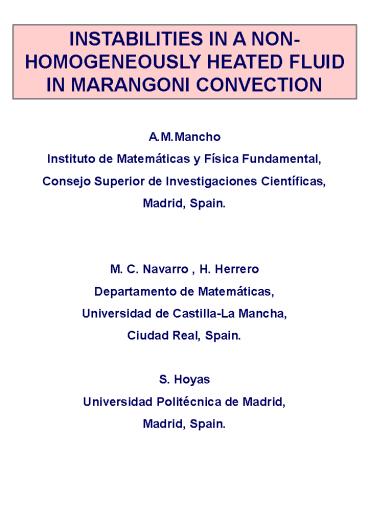Presentacin de PowerPoint - PowerPoint PPT Presentation
1 / 21
Title:
Presentacin de PowerPoint
Description:
Chebyshev Collocation for a Convective Problem in Primitive Variables Formulation. ... THE COLLOCATION METHOD. At each step unknowns are expanded in Chebyshev ... – PowerPoint PPT presentation
Number of Views:19
Avg rating:3.0/5.0
Title: Presentacin de PowerPoint
1
INSTABILITIES IN A NON- HOMOGENEOUSLY HEATED
FLUID IN MARANGONI CONVECTION
A.M.Mancho Instituto de Matemáticas y Física
Fundamental, Consejo Superior de Investigaciones
Científicas, Madrid, Spain. M. C. Navarro ,
H. Herrero Departamento de Matemáticas,
Universidad de Castilla-La Mancha, Ciudad Real,
Spain. S. Hoyas Universidad Politécnica de
Madrid, Madrid, Spain.
2
PHYSICAL SETUP
Domain
3
RELATED THEORETICAL WORKS
We have used numerical techniques developed and
theoretically justified in these
articles Herrero, H Mancho, A.M. On pressure
boundary conditions for thermoconvective
problems. Int. J. Numer. Meth. Fluids 39 (2002),
391-402. H. Herrero, S. Hoyas, A. Donoso, A. M.
Mancho, J.M. Chacón, R.F Portugues y B. Yeste.
Chebyshev Collocation for a Convective Problem in
Primitive Variables Formulation. J. of
Scientific Computing 18 (3),315-318 (2003)
4
RELATED THEORETICAL WORKS
These numerical techniques have been applied to
a similar problem with lateral constant
temperature gradient. Hoyas, S. Herrero, H.
Mancho, A. M. Bifurcation diversity in dynamic
thermocapillary liquid layers. Phys. Rev. E 66
(2002), 057301-1-057301-4. Hoyas, S. Herrero,
H. Mancho, A.M. Thermal convection in a
cylindrical annulus heated laterally. J. Phys. A
Math. Gen. 35 (2002), 4067-4083. Hoyas, S.
Mancho A.M. Herrero, H. Thermocapillar and
thermogravitatory waves in a convection problem.
Theoretical and Computational Fluid dynamics 18
(2004), 2-4, 309-321. Hoyas, S Mancho, A.M.
Herrero, H. Garnier, N. Chiffaudel, A.
Benard-Marangoni convection in a differentially
heated cylindrical cavity. Phys. of Fluids. 17,
054104-1,12 (2005).
Linear heating
5
RELATED EXPERIMENTAL WORKS
These experiments describe a similar problem with
lateral constant temperature gradient. R.J.
Riley and G.P. Neitzel, Instability of
thermocapillary-buoyancy convection in shallow
layers. Part 1. Characterization of steady and
oscillatory instabilities, J. Fluid Mech. 359,
143 (1998). N. Garnier, Ondes non lineaires a
une et deux dimensions dans une mince couche de
fluide, Ph.D. thesis, Université Paris 7, France,
2000. J. Burguete, N. Mukolobwiez, F. Daviaud, N
Garnier, A. Chiffaudel, Buoyant-thermocapillary
instabilities in extended liquid layers subjected
to a horizontal temperature, Phys. of Fluids 13
(10) 2773-2787 (2001).
6
FORMULATION OF THE PROBLEM
BASIC EQUATIONS
No gravity effects Pr gt Prandtl number Domain
BOUNDARY CONDITIONS for the velocity
are, M gt Marangoni number
7
BOUNDARY CONDITIONS for the temperature
are, B gt Biot number b gt Gaussian
width. Heating shape S/Tugt Quotient of lateral
and vertical temperature differences Regularity
conditions at the origin Multiparametric
problem G, Pr, M, B, b, S/Tu
Control Heat related parameters
parameter
8
THE BASIC STATE
Stationary and axisymmetric, Regularity
conditions for the basic state at the origin
are, We solve the basic state with a
Newton-Raphson iterative method. The equations
and boundary conditions are linearized at each
step s, around solutions at step s-1
9
THE COLLOCATION METHOD
At each step unknowns are expanded in Chebyshev
polynomials Basic equations are evaluated at
collocation points Boundary Conditions are
evaluated at
10
With those rules we obtain 4xLxM equations and
unknowns. Some results are
S/Tu 0.001
S/Tu 0.5
11
THE LINEAR STABILITY ANALYSIS
We perturb the basic state Regularity
conditions at r0 are The perturbation
fields are expanded in Chebyshev
polynomials, A trick for m1,
12
The number of unknowns and equation are for
m1, 4xLxM(L-1)xM otherwise 5xLxM
CONVERGENCE RESULTS
z-coordinate
r-coordinate
B0.05, M92Tu, G10, S1ºC, b0.8
13
THE STABILITY RESULTS
G10, Pr0.4 THE INFLUENCE OF THE HEAT
PARAMETERS The shape of the heating b on the
range 0.8-10
14
Biot number fixed to B0.05, b0.8 The
influence of S/Tu S/Tu 0.001-1 Thresholds
M
S/Tu
15
Patterns at critical thresholds S/Tu0 S/
Tu0.01
16
Patterns at critical thresholds S/Tu0.05
S/Tu0.5
17
G10, B0.05 THE INFLUENCE OF THE PRANDTL
NUMBER For Pr0.1 thresholds diminish
M
S/Tu
18
Pr0.4, B0.05, THE INFLUENCE OF ASPECT RATIO at
G2 thresholds are M13000 for S/Tu
0.02 Patterns have wavenumber
m1 Pr0.01, B0.05 and S/Tu -1 these
waves are possible
19
COMPARISONS WITH EXPERIMENTS
G11.76, S/Tu0.05, B0.2, Pr , M 542
N. Garnier y A. Chiffaudel, Eur. Phys. J. (2001)
G 33.4, S/Tu1, B0.2, Pr , M 642
Hoyas, Mancho, Herrero, Garnier and Chiffaudel,
Physics of Fluids, (2005)
20
COMPARISONS WITH EXPERIMENTS
Hoyas, Mancho, Herrero, Garnier and Chiffaudel,
Physics of Fluids, (2005)
G 52.9, S/Tu 0.6, B0.2, Pr , M 508
21
CONCLUSIONS
Non-homogeneous heating develop new instabilities
on Marangoni convection. Some of them are also
present in purely buoyant convection (see MC
Navarro poster) The shape of the heating b has
been shown to be less influencial than the ratio
S/Tu S/Tu may increase considerably
instability thresholds cause spiral waves
and other oscillatory instabilities. is on
the origin of localized patterns mainly for large
values. Once S/Tu is large enough, localized
patterns are then due to combined effects of
other parameters as Pr, B and G































